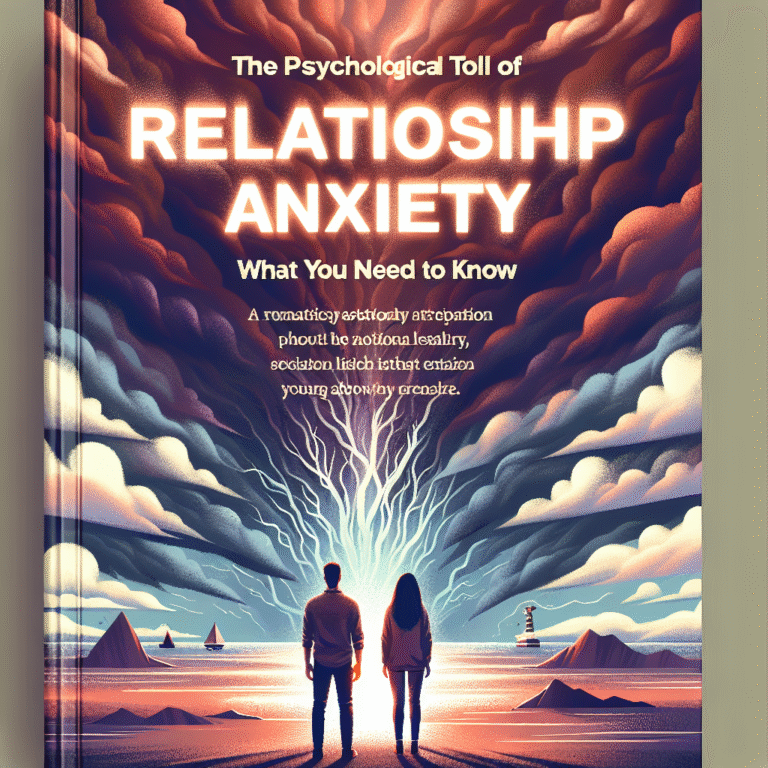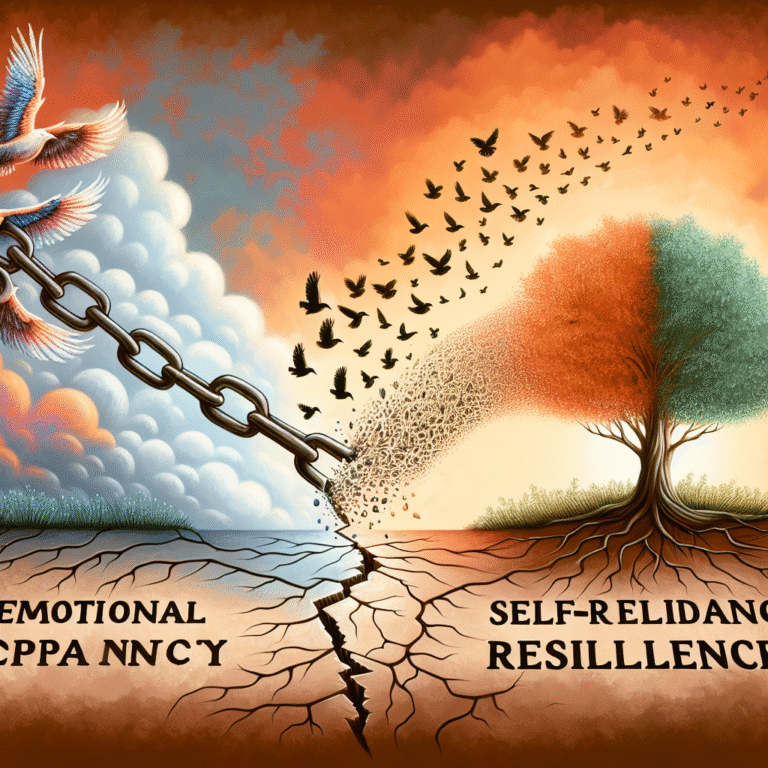
Introduction
Imagine standing on the edge of a beautiful, vast ocean. The waves are gentle, inviting—you can feel the warmth of the sun on your face. But instead of stepping forward, you hesitate. You’re worried about what might happen if you let go. This hesitation mirrors the experience of many who find themselves enmeshed in codependent relationships. Codependency isn’t just a buzzword; it’s a dynamic that can insidiously take root, affecting our mental health, self-esteem, and overall well-being. In this comprehensive article, we’ll explore The Cost of Codependency: How Overdependence Impacts Your Well-being and offer insights that can help break the cycle.
Understanding Codependency
What is Codependency?
Codependency can be understood as an unhealthy reliance on another person for emotional support and validation. This pattern often arises in relationships where one partner’s needs overshadow their own. It permeates familial, romantic, and even platonic relationships.
Historical Context
The term "codependency" first appeared in the 1970s, primarily within the context of addiction. It described spouses and partners who enabled the addictive behavior of their loved ones. However, over the years, it has evolved to encompass a wider range of dysfunctional relationships, impacting countless individuals.
Characteristics of Codependent Relationships
| Characteristics | Description |
|---|---|
| Low Self-Esteem | Individuals often feel worthless without their partner. |
| People-Pleasing Behavior | A constant need to make others happy at the expense of one’s own needs. |
| Fear of Abandonment | An overwhelming fear of being alone leads to unhealthy attachments. |
| Enabling | Attempting to fix or control others’ problems, reinforcing negative behaviors. |
The Psychological Toll of Codependency
Mental Health Implications
Codependency can lead to anxiety, depression, and low self-worth. When individuals focus primarily on another’s needs, they often neglect their own emotional health, resulting in chronic stress and discontent.
Case Study: Sarah and Mark
Sarah always prioritized Mark’s happiness over her own. She would sacrifice her social life to ensure Mark was satisfied, leading to feelings of isolation and depression when Mark was unavailable. This relationship ultimately took a toll on Sarah, highlighting the emotional strain that can accompany codependency.
Self-Identity Struggles
Individuals entrenched in codependent relationships often lose sight of their identity. They may struggle to establish personal interests or passions outside the relationship, leading to a sense of emptiness.
Codependency in Action
Family Dynamics
Often, codependency is deep-rooted in familial relationships. Parents who subtly encourage codependent behavior can inadvertently lead their children to develop these patterns.
Case Study: The Johnson Family
In the Johnson household, the mother relied heavily on her daughter, Emma, to provide emotional support after a painful divorce. Emma learned to suppress her own feelings, always putting her mother’s needs first, which stunted her emotional growth and limited her adult relationships.
Romantic Relationships
Romantic codependency can lead to a cycle of enmeshment where partners become overly involved in each other’s lives, often to the detriment of their own personal growth.
Case Study: Alex and Jamie
In a romantic dynamic, Alex and Jamie constantly found themselves disagreeing over minor issues. Rather than resolving their conflicts healthily, they ended up enabling each other’s bad behaviors—Alex would ignore his needs for the sake of Jamie’s comfort, leading to resentment and frustration.
Identifying the Signs of Codependency
Recognizing the signs of codependency is the first step toward healing. Here are some effective strategies for individuals to assess their relationships:
- Reflection: Take time to contemplate your feelings and behaviors in the relationship.
- Journaling: Document your emotions and experiences to identify patterns of reliance.
- Seek Feedback: Engage trusted friends or family members for an outside perspective on your relationship dynamics.
Breaking the Cycle of Codependency
Self-Awareness and Acceptance
Becoming aware of one’s patterns is crucial. Accepting that codependency exists is a transformative step toward recovery. Self-reflection exercises can help individuals identify their dependencies clearly.
Setting Healthy Boundaries
Establishing boundaries allows individuals to communicate their needs effectively, fostering a healthier relational dynamic.
- Identify Personal Limits: Understanding what is acceptable and what isn’t is foundational.
- Communicate Clearly: Be open about your feelings and limitations with your partner or loved one.
Seeking Professional Help
Therapy can be incredibly beneficial for individuals caught in the web of codependency. A mental health professional can provide valuable tools and strategies for overcoming ingrained patterns.
Case Study: Tom’s Journey
Tom sought therapy after realizing his codependent nature led to a string of unhealthy relationships. Through counseling, he learned how to set boundaries, ultimately leading to healthier connections with others and a greater sense of self-worth.
The Cost of Codependency in Everyday Life
Social Isolation
Codependent individuals often find themselves isolated from friends and family as they focus exclusively on their partner’s needs. The emotional burden becomes so heavy that they withdraw from social interactions.
Financial Implications
Financial codependency can affect individuals and families significantly. One partner may end up controlling the finances, limiting the other’s independence and capability to manage their resources.
Table: Financial Impact of Codependency
| Aspect | Description |
|---|---|
| Budgeting | One partner takes control, often leading to financial strain on the other. |
| Career | Limited opportunities for self-care or education due to focusing on the partner’s needs. |
| Trust Issues | Financial mismanagement can breed mistrust within the relationship. |
Emotional Well-being
Overdependence leads to emotional exhaustion, creating a cycle of anxiety and depression that can be hard to break. Understanding the emotional costs can illuminate why taking the steps to break free from codependent patterns is essential.
Conclusion
Key Takeaways
In exploring The Cost of Codependency: How Overdependence Impacts Your Well-being, we’ve uncovered the various manifestations and implications of codependent relationships. From emotional tolls to social isolation and financial implications, the consequences are varied and significant.
Actionable Insights
Breaking free from a codependent cycle can be daunting, but it’s essential for reclaiming your life and well-being. Start small—focus on self-care, nurture your interests, and communicate effectively. Building a life rich in personal fulfillment is possible, and the journey toward emotional freedom begins with understanding and awareness.
Motivational Takeaway
Remember, your emotions matter. Prioritizing yourself isn’t selfish; it’s essential for maintaining healthy relationships. You’re worthy of love that allows you to grow, thrive, and express your authentic self.
FAQs
1. What are the main signs of codependency?
Common signs include low self-esteem, a constant need for approval, neglecting personal needs, and controlling behaviors towards others.
2. Can someone recover from codependency?
Yes, recovery is possible through self-awareness, seeking therapy, and learning to establish healthy boundaries.
3. How does codependency affect emotional health?
It can lead to anxiety, depression, low self-worth, and a profound sense of emotional exhaustion.
4. Are there specific therapy types that help with codependency?
Cognitive Behavioral Therapy (CBT) and Dialectical Behavior Therapy (DBT) are effective in addressing codependency issues.
5. How can I approach a loved one who I believe is codependent?
Approach the conversation gently and compassionately. Express your concerns without judgment, and encourage them to seek professional help.
By understanding The Cost of Codependency: How Overdependence Impacts Your Well-being, individuals can take crucial steps towards healing and creating fulfilling, healthy relationships. Creating space to grow, thrive, and embrace your true self is not just desirable—it’s necessary.














